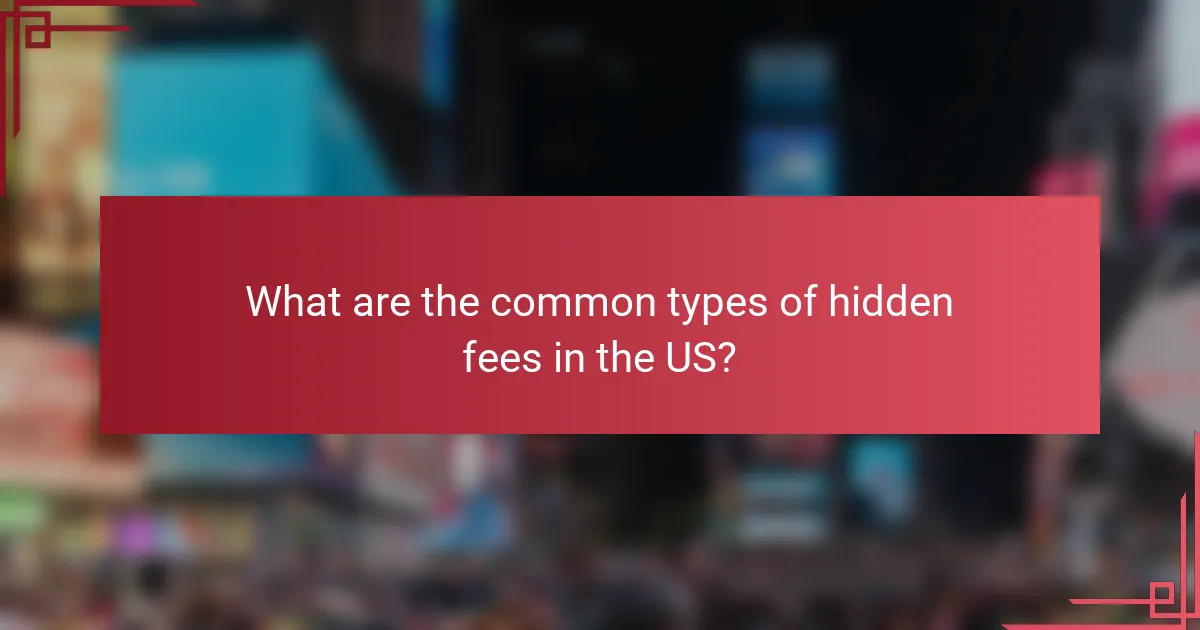Hidden fees can substantially inflate the total cost of products and services, often without consumers realizing it. These fees, which can include bank charges, service fees, and late payment penalties, not only affect personal finances but also contribute to a growing distrust in businesses. By actively researching and inquiring about potential hidden costs, consumers can better navigate their expenses and make informed financial decisions.

What are the common types of hidden fees in the US?
Hidden fees in the US can significantly increase the total cost of products and services without consumers being aware. Common types include bank fees, service charges, subscription fees, late payment fees, and processing fees, each impacting your finances in different ways.
Bank fees
Bank fees often include monthly maintenance charges, ATM fees, and overdraft fees. These charges can vary widely; for example, monthly maintenance fees can range from $5 to $15, depending on the bank and account type. To avoid these fees, consider using banks that offer no-fee accounts or maintaining a minimum balance.
Service charges
Service charges are additional fees that businesses apply for specific services, such as account setup or maintenance. These can be particularly common in industries like telecommunications and utilities. Always read the fine print to understand what services incur these charges and look for alternatives that offer transparent pricing.
Subscription fees
Subscription fees are recurring charges for services like streaming platforms, software, or memberships. These fees can be monthly or annual and often include automatic renewals, which can lead to unexpected charges. Regularly review your subscriptions to ensure you are only paying for services you actively use.
Late payment fees
Late payment fees are penalties imposed when bills are not paid by the due date. These fees can range from $15 to $50, depending on the service provider. To avoid late fees, set up reminders or automatic payments for recurring bills.
Processing fees
Processing fees are charges for handling transactions, often seen in credit card payments or online purchases. These fees can be a percentage of the transaction or a flat rate. When making purchases, especially large ones, check if processing fees apply and factor them into your total cost.

How do hidden fees impact consumers?
Hidden fees significantly affect consumers by increasing their overall expenses and eroding trust in businesses. These unexpected charges can lead to financial strain and complicate budgeting efforts.
Increased overall costs
Hidden fees contribute to higher overall costs for consumers, often making products or services more expensive than initially advertised. For example, a subscription service may promote a low monthly fee but add charges for cancellation or additional features, resulting in total costs that are much higher than anticipated.
Consumers should carefully review all terms and conditions before committing to any service. Understanding potential hidden fees can help avoid surprises that inflate expenses by 10-30% or more in some cases.
Reduced trust in companies
When consumers encounter hidden fees, their trust in companies diminishes. Transparency is crucial for maintaining a positive relationship; unexpected charges can lead to feelings of betrayal and skepticism about future transactions.
Companies that consistently disclose all fees upfront tend to foster stronger customer loyalty. Building trust through transparency can differentiate a business in competitive markets.
Budgeting challenges
Hidden fees complicate budgeting for consumers, making it difficult to accurately forecast monthly expenses. When unexpected charges arise, they can disrupt financial plans and lead to overspending.
To manage budgeting effectively, consumers should track all expenses, including any hidden fees. Utilizing budgeting tools or apps can help identify patterns and prepare for potential additional costs, ensuring a more accurate financial outlook.

What steps can consumers take to identify hidden fees?
Consumers can take several proactive steps to identify hidden fees associated with services or products. By being diligent in their research and asking the right questions, they can uncover potential costs that may not be immediately obvious.
Read contracts carefully
Reading contracts thoroughly is essential for identifying hidden fees. Look for sections that outline fees, charges, and any conditions that may trigger additional costs. Pay attention to fine print, as it often contains crucial information regarding fees that may not be highlighted elsewhere.
Common areas to check include cancellation policies, service upgrades, and maintenance fees. Understanding these terms can help consumers avoid unexpected charges later on.
Ask direct questions
Asking direct questions about fees can clarify any uncertainties. When engaging with service providers, inquire specifically about any potential hidden fees that may apply. This includes asking about setup fees, monthly service charges, and penalties for early termination.
Don’t hesitate to request a breakdown of all costs associated with a service or product. A transparent provider should be willing to provide this information without hesitation.
Compare service providers
Comparing service providers is a practical way to identify hidden fees. Different companies may have varying fee structures, so evaluating multiple options can reveal which providers are more transparent about their costs. Look for reviews or consumer reports that highlight experiences with hidden fees.
Consider creating a simple comparison table that lists each provider alongside their fees and services. This visual aid can help you make informed decisions based on the total cost of ownership rather than just the initial price.

How can companies improve transparency regarding fees?
Companies can enhance transparency regarding fees by adopting clear pricing structures, conducting regular fee audits, and implementing customer education initiatives. These practices help build trust and ensure customers understand the costs associated with their services.
Clear pricing structures
Clear pricing structures involve presenting fees in a straightforward manner without hidden charges. Companies should provide detailed breakdowns of costs, including any potential additional fees, so customers can easily understand what they are paying for.
For example, a subscription service might list the monthly fee, any setup costs, and possible transaction fees separately. This clarity allows customers to make informed decisions and reduces the likelihood of disputes over unexpected charges.
Regular fee audits
Conducting regular fee audits helps companies identify and eliminate unnecessary or outdated fees. This process involves reviewing all charges to ensure they are justified and align with industry standards.
Companies can schedule audits annually or biannually, comparing their fees against competitors to ensure they remain competitive. This practice not only improves transparency but also enhances customer satisfaction by minimizing unexpected costs.
Customer education initiatives
Customer education initiatives aim to inform clients about the fees associated with products or services. Companies can use various methods, such as webinars, FAQs, and informative articles, to explain how fees are structured and what factors influence them.
For instance, a bank might offer workshops on understanding service fees, helping customers grasp the implications of their financial choices. Educated customers are more likely to feel confident in their decisions and less likely to be surprised by fees.

What regulations exist to combat hidden fees in the US?
In the US, various regulations aim to increase transparency and reduce hidden fees in financial transactions. These rules require lenders and service providers to disclose fees upfront, helping consumers make informed decisions.
Truth in Lending Act
The Truth in Lending Act (TILA) mandates clear disclosure of credit terms, including interest rates and fees, to consumers. This law ensures that borrowers understand the total cost of borrowing, which includes any hidden fees that may apply.
For example, lenders must provide a standardized disclosure form that outlines all costs associated with a loan, allowing consumers to compare offers easily. Failure to comply can result in penalties for lenders.
Consumer Financial Protection Bureau guidelines
The Consumer Financial Protection Bureau (CFPB) enforces regulations that protect consumers from deceptive practices, including hidden fees. The CFPB provides guidelines that require financial institutions to clearly disclose all fees associated with their products and services.
These guidelines help consumers identify and question any unexpected charges, promoting accountability among service providers. Consumers can report violations to the CFPB, which can take action against non-compliant companies.
State-specific regulations
In addition to federal laws, many states have their own regulations addressing hidden fees. These state-specific laws may impose stricter disclosure requirements or limit the types of fees that can be charged.
For instance, some states may require businesses to provide a detailed breakdown of all fees before a transaction is finalized. Consumers should familiarize themselves with local regulations to better understand their rights and protections regarding hidden fees.



